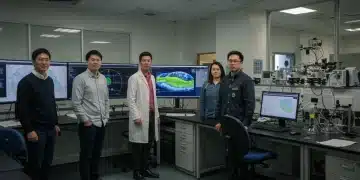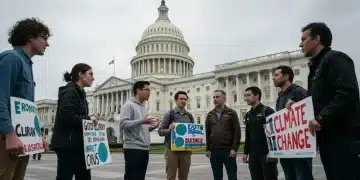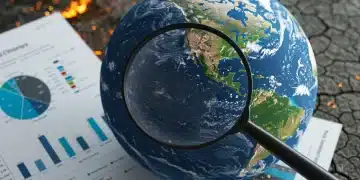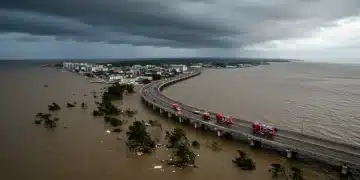Global Warming’s Trillion-Dollar U.S. Economic Cost by 2030
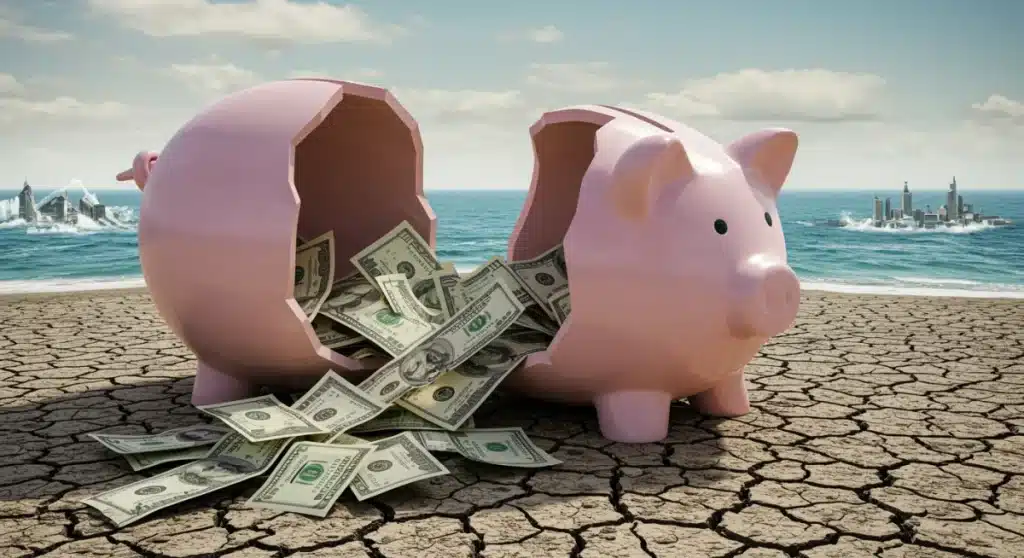
The financial impact of global warming on the U.S. economy is rapidly escalating, with recent projections indicating potential costs in the trillions of dollars by 2030, demanding immediate policy and economic adjustments.
The escalating threat of climate change is no longer a distant concern; its immediate and profound consequences are now being felt across the United States. New reports highlight that the global warming financial impact on the U.S. economy could reach trillions of dollars by 2030, a stark warning for policymakers and citizens alike.
Understanding the Trillion-Dollar Threat
Recent analyses from leading economic institutions and climate research centers are painting a grim picture of the future financial landscape. These studies collectively project that the U.S. economy stands to lose trillions of dollars within the next decade due to unmitigated global warming. This isn’t merely an abstract figure; it represents tangible losses across critical sectors, from agriculture to infrastructure and public health.
The economic models consider a range of factors, including increased frequency and intensity of extreme weather events, disruptions to supply chains, decreased labor productivity, and substantial costs associated with disaster recovery and adaptation measures. The sheer scale of these projections underscores the urgency of addressing climate change with robust and immediate action.
Direct Economic Losses from Extreme Weather
Extreme weather events, such as hurricanes, wildfires, and floods, are becoming more common and severe. These events cause immediate and devastating financial damage, requiring billions in recovery efforts. The costs are borne by individuals, businesses, and government entities, straining budgets and diverting resources from other essential areas.
- Infrastructure Damage: Roads, bridges, and utilities suffer extensive harm, requiring costly repairs and upgrades.
- Agricultural Ruin: Crop failures and livestock losses due to droughts and floods impact food supply and farmer livelihoods.
- Property Destruction: Homes and businesses are destroyed, leading to massive insurance claims and rebuilding expenses.
Sector-Specific Vulnerabilities and Costs
While the overall economic impact is staggering, specific sectors of the U.S. economy are particularly vulnerable to the effects of global warming. These sectors often form the backbone of regional economies, meaning localized climate impacts can have ripple effects nationwide. Understanding these specific vulnerabilities is crucial for developing targeted mitigation and adaptation strategies.
From coastal communities facing rising sea levels to agricultural heartlands battling prolonged droughts, the diversity of climate impacts necessitates a nuanced approach. The interconnectedness of modern economies means that distress in one sector can quickly propagate, affecting supply chains, labor markets, and consumer spending across the country.
Agriculture Under Threat
The agricultural sector faces immense challenges from changing weather patterns. Prolonged droughts, unpredictable rainfall, and extreme temperatures reduce crop yields and livestock health, leading to higher food prices and lower farmer incomes. This directly impacts food security and contributes to inflationary pressures within the economy.
- Reduced Crop Yields: Heat stress and water scarcity severely limit agricultural output.
- Increased Pest Infestations: Warmer climates can lead to the proliferation of agricultural pests.
- Water Scarcity: Diminished freshwater resources impact irrigation and livestock hydration.
The Rising Cost of Public Health
The health implications of global warming translate directly into significant economic costs. Increased heat-related illnesses, the spread of vector-borne diseases, and respiratory problems due to poor air quality place an enormous burden on the healthcare system. These costs include direct medical expenses, lost productivity from illness, and investments in public health infrastructure.
Beyond direct treatment, there are also costs associated with preventative measures, public awareness campaigns, and research into climate-sensitive diseases. The strain on emergency services during extreme heatwaves or disease outbreaks further exemplifies the economic ramifications of a warming planet on human well-being.
Healthcare System Strain
Hospitals and clinics experience increased patient loads during climate-related health crises. This necessitates more resources, staff, and often, specialized equipment, leading to higher operational costs and potential shortages in care capacity. The mental health impacts of climate disasters also contribute to this growing economic burden.
Infrastructure at Risk: A Costly Challenge
America’s aging infrastructure is particularly susceptible to climate change impacts. Rising sea levels threaten coastal roads, bridges, and ports, while intense storms and floods damage inland transportation networks and energy grids. The cost to repair, reinforce, and relocate critical infrastructure is projected to be astronomical, diverting funds from other public services.
Utilities, including power and water systems, face constant threats from extreme weather. Power outages can cripple local economies for days or weeks, and contaminated water supplies pose severe public health risks, both carrying substantial economic penalties. Proactive investments in resilient infrastructure are urgently needed but come with a hefty price tag.

Coastal Protection and Relocation
Coastal communities face the dual challenge of protecting existing infrastructure from rising sea levels and, in some cases, considering managed retreat or relocation. Both options are incredibly expensive and involve complex social and political considerations, adding another layer to the economic burden of global warming.
- Sea Wall Construction: Building and maintaining robust coastal defenses requires massive capital investment.
- Erosion Control: Efforts to combat shoreline erosion are ongoing and costly.
- Community Relocation: Moving entire communities away from high-risk areas is a complex and financially draining endeavor.
Disruptions to Supply Chains and Labor Productivity
The interconnected global economy means that climate impacts in one region can have far-reaching effects on supply chains. Extreme weather events can disrupt transportation routes, damage production facilities, and delay the delivery of goods and services. This leads to increased costs for businesses, potential shortages, and ultimately, higher prices for consumers.
Furthermore, rising temperatures and poor air quality can significantly reduce labor productivity, particularly in outdoor industries like construction and agriculture. Workers are less efficient, and work stoppages due to unsafe conditions become more frequent, impacting economic output and individual earnings. The global warming financial impact is truly pervasive.
Impact on Manufacturing and Logistics
Manufacturing operations rely heavily on stable supply chains and energy access. Climate-induced disruptions to either can halt production, leading to significant financial losses. Logistics, including shipping and trucking, are also vulnerable to weather-related delays and damage, increasing operational costs and delivery times.
The Cost of Inaction vs. Investment in Resilience
The projections of trillions in economic losses by 2030 underscore a critical economic choice: continue with current trajectories and bear exponentially increasing costs, or invest significantly now in mitigation and adaptation. Experts argue that proactive investment in renewable energy, resilient infrastructure, and sustainable practices, while costly upfront, will yield substantial long-term economic benefits and avert much larger future losses.
Delaying action only exacerbates the problem, making future solutions more expensive and less effective. The economic case for climate action is becoming increasingly clear, moving beyond environmental concerns to a fundamental imperative for economic stability and growth. The global warming financial impact is a clear call to action.
Economic Benefits of Green Technologies
Investing in green technologies and renewable energy sources not only reduces carbon emissions but also creates new industries, jobs, and economic opportunities. These investments can drive innovation, improve energy independence, and position the U.S. as a leader in the global green economy.
- Job Creation: Growth in renewable energy sectors generates new employment opportunities.
- Technological Innovation: Investments spur advancements in sustainable technologies.
- Energy Independence: Reduced reliance on fossil fuels enhances national energy security.
| Key Impact Area | Brief Description |
|---|---|
| Extreme Weather Costs | Billions in damage and recovery from hurricanes, wildfires, and floods annually. |
| Agricultural Losses | Reduced crop yields and livestock due to droughts and unpredictable weather. |
| Public Health Burden | Increased healthcare costs from heat-related illnesses and disease spread. |
| Infrastructure Damage | Coastal erosion, damaged roads, and utility disruptions require massive repair costs. |
Frequently Asked Questions About Global Warming’s Economic Impact
Recent analyses project that global warming could cost the U.S. economy trillions of dollars by 2030. These costs stem from a range of factors, including extreme weather events, health impacts, and disruptions to key economic sectors like agriculture and infrastructure.
Sectors most vulnerable include agriculture, due to altered growing seasons and water scarcity; infrastructure, facing damage from extreme weather; and public health, grappling with increased heat-related illnesses and vector-borne diseases. Coastal communities also face significant threats from rising sea levels.
Extreme weather events like hurricanes, wildfires, and floods cause direct property damage, infrastructure destruction, and agricultural losses. The costs extend to emergency response, recovery efforts, and long-term rebuilding, placing severe strain on local and national budgets.
Yes, investments in green technology and renewable energy are seen as crucial for mitigation. While requiring upfront capital, these investments can reduce carbon emissions, foster new industries, create jobs, and build economic resilience, potentially averting much larger future climate-related losses.
Rising temperatures and poor air quality directly impact labor productivity, especially in outdoor industries. This leads to reduced efficiency, increased work stoppages due to unsafe conditions, and higher healthcare costs, collectively diminishing overall economic output and individual earning potential.
What Happens Next
The projections regarding the global warming financial impact represent a critical juncture for U.S. economic policy. Watch for accelerated discussions in Congress and state legislatures concerning climate resilience funding, infrastructure upgrades, and incentives for renewable energy. Businesses, particularly those in vulnerable sectors like insurance and agriculture, are likely to intensify their adaptation strategies. Expect to see increased pressure on international bodies to strengthen global commitments to emissions reductions, as the economic ramifications become undeniable and increasingly immediate for major world economies. The next few years will be pivotal in determining whether the U.S. can mitigate these projected trillions in costs or if they become an unavoidable reality.

